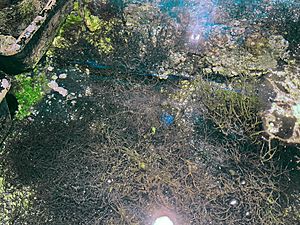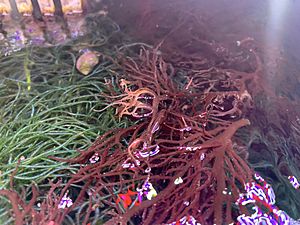Long ogo facts for kids
Quick facts for kids Long ogo |
|
|---|---|
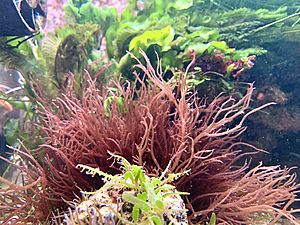 |
|
| Gracilaria parvispora in a planted marine aquarium | |
| Scientific classification | |
| Genus: |
Gracilaria
|
| Species: |
parvispora
|
Gracilaria parvispora, also called long ogo, red ogo, or just ogo, is a large type of red seaweed. It is found only in Hawaii. This seaweed is very popular to eat and is grown in special farms in the ocean. It is also used in home aquariums. In Hawaiian, it is known as limu ogo.
Contents
What is Ogo?
Gracilaria parvispora has pointed, round branches that grow from a main stem. These branches are about 1 to 4 millimeters (0.04 to 0.16 inches) wide. The main stem is about 0.8 to 3.5 millimeters (0.03 to 0.14 inches) wide. It attaches to rocks with a single "holdfast," which is like a root. This seaweed can grow very long, up to 60 centimeters (24 inches)!
The color of Gracilaria parvispora can change a lot. While it is usually red, it can also be yellow, brown, green, white, or even black. Its color depends on how much sunlight it gets, how strong the water current is, and how deep it grows. The way its branches grow can also change. If there is less water flow or salt, the branches tend to grow closer together.
Where Does Ogo Live?
Natural Homes
Gracilaria parvispora naturally lives only in Hawaii. You can find it around the islands of Oahu and Molokai. It grows in places like Kāneʻohe Bay and Ke’ehi Lagoon. Some populations on Molokai were started by people. They planted small pieces of the seaweed there between 1983 and 1985.
Some people think Gracilaria parvispora might have come from Asia a long time ago. They believe it was brought to Hawaii for farming. However, there is no real proof of this. It's also possible that it was only found in a small area of Hawaii. Then, seaweed farming helped it spread to other parts of the islands.
Found in Other Places
Gracilaria parvispora has also been found in Baja California Sur, a part of Mexico. Here, it is an introduced species, meaning it was brought there by people. It has been seen in places like San Ignacio Lagoon. Scientists are still learning how this seaweed affects the local plants and animals in the eastern Pacific Ocean.
How Ogo Lives and Grows
Gracilaria parvispora likes to live on reef flats and in areas with sand-covered rocks. It can handle many different conditions in the water. It prefers water that has lots of nutrients, moderate to strong light, and good water flow. It also likes specific levels of dKH (8-12), pH (8.1-8.4), and salinity (1.010-1.025). The best water temperature for it is between 22 and 28 degrees Celsius (72-82 degrees Fahrenheit). It also needs certain amounts of calcium, magnesium, phosphate, and nitrate.
When conditions are just right, this seaweed grows very fast. It can increase its total weight (called biomass) by 150% or more in just one month! It is one of the fastest-growing types of Gracilaria. It is also one of the largest red algae found in the Hawaiian Islands.
Even though it used to be common, Gracilaria parvispora has been collected too much. An invasive seaweed called Gracilaria salicornia has largely taken its place around Oahu.
Ogo and People
Gracilaria parvispora is one of the three most popular edible seaweeds in the Hawaiian Islands. People might even export dried Gracilaria parvispora to other places. In Hawaii, it has been used in many dishes. These include poke, and it is also eaten raw. It is part of Hawaiian, Korean, Filipino, Japanese, and Caucasian cooking traditions.
In the 1930s, people started collecting Gracilaria parvispora to sell in Oahu. It became the most popular seaweed in Honolulu fish markets until the 1970s. But because too much was collected, it became rare in the wild. This led to other types of seaweed being brought in to replace it. For example, Gracilaria tikvaheae from the Atlantic Ocean was used. However, it tastes and looks different from Gracilaria parvispora. In 1988, it became against the law to collect Gracilaria parvispora that had special reproductive parts called cystocarps.
Growing Ogo on Farms
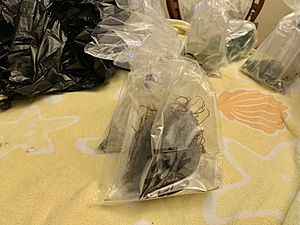
Scientists have studied a lot about growing Gracilaria parvispora on farms in the ocean, which is called mariculture. In 1991, researchers tried growing it in old Hawaiian fishponds. They found it grew well in floating baskets. It grew best with slow water currents. Stronger currents could cause other unwanted plants to grow on it.
It is also hard to grow Gracilaria parvispora in tanks. It often breaks apart after a few weeks. Setting up tanks for growing seaweed can also be very expensive.
Ogo's Nutrition
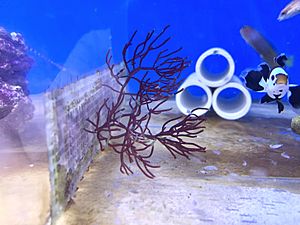
In 2003, scientists looked at the nutrients in many edible Hawaiian seaweeds, including Gracilaria parvispora. They found that fresh Gracilaria parvispora is mostly water (about 90%). When dried, it has a good amount of protein, carbohydrates, and some fats. It also contains important minerals like nitrogen, phosphorus, potassium, magnesium, and calcium. It also has iron and zinc. Even though it is nutritious, it is not unusually high in nutrients compared to other seaweeds.
Ogo in Aquariums
Gracilaria parvispora is a very useful seaweed for marine aquaria (saltwater fish tanks). It is the most popular type of Gracilaria for aquarium hobbyists. It is known to be very tough and easy to keep. However, it does best when given extra trace elements, like iron.
You can grow this seaweed attached to rocks or let it float freely in the tank. If it floats, gently tumbling it helps remove dirt. This seaweed is often used in special sections of tanks called refugia. It helps clean the water by removing extra nutrients. It can also be a place for seahorses to hold onto.
Because it grows so fast, you can trim Gracilaria parvispora from your refugium. These trimmings make a healthy food source for many plant-eating fish and invertebrates. This includes fish like tangs, rabbitfish, and blennies. If the seaweed starts to turn white, it means it is dying. You should remove those parts.


